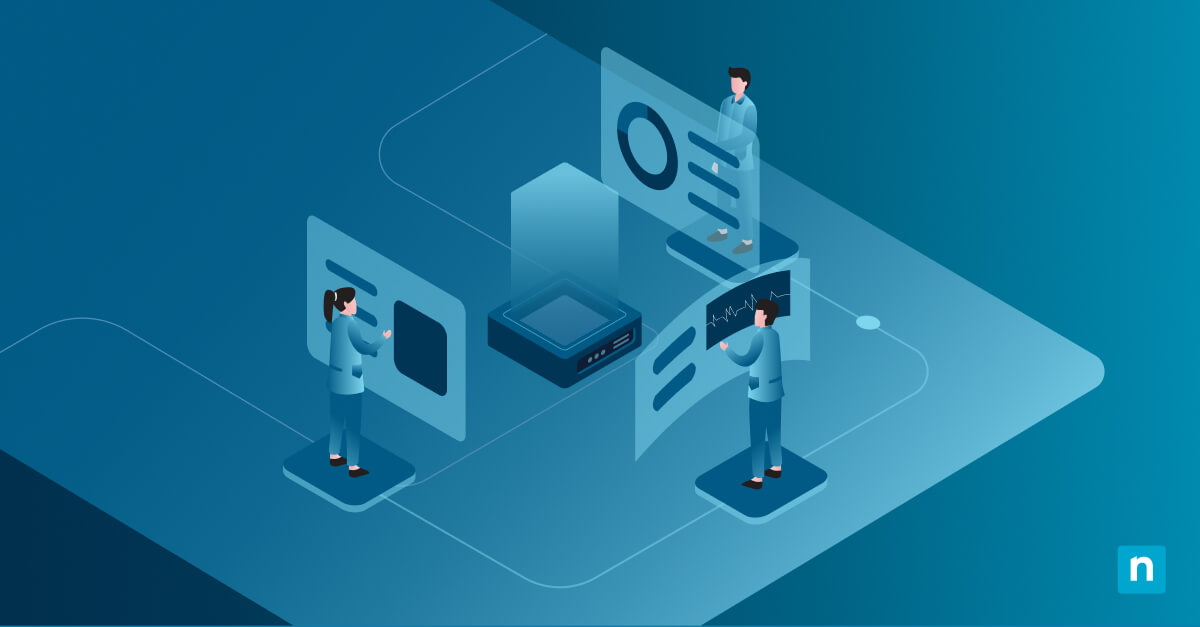From the proliferation of artificial intelligence and machine learning to an unpredictable economic and geopolitical landscape, 2023 was an eventful year. The top IT department issues have become even more diverse and complex.
In 2024, businesses will need to address IT infrastructure and disaster recovery, cybersecurity threats, data privacy policies, and the effects of AI and automation on their industries to stay ahead of the curve.
Effective IT strategy can be the difference between success and failure for a business, especially when daily operations depend so heavily on technologically complex infrastructure. Although AI can be leveraged to help your business, it also poses an increased risk to your cybersecurity and data privacy.
Additionally, employees requesting remote or hybrid work is likely to continue in 2024, a trend that businesses may need to accommodate to retain talent.
In 2024, your business will have plenty of challenges to face. However, ensuring that your infrastructure and strategies are sound will solve several concerns, leaving you free to focus on value-led priorities.
Top IT Department Issues in 2024
The vast majority of companies are still highly vulnerable to attack despite mitigation efforts, and 93% of company networks were found to be vulnerable to unauthorized access during penetration testing.
By the end of 2023, many businesses, including Microsoft, had found that attackers had begun using AI to develop increasingly sophisticated cyberattacks that were less detectable and more difficult to mitigate. Ransomware attacks continue globally, as do social engineering attacks.
Despite many companies resolving to increase IT budgets in 2023, CIOs and IT service providers are still struggling to accomplish their goals without overspending. A related concern is the growing skills gap, which, combined with inflation and generally rising costs, will be a pressing challenge for 2024. The question for many companies, then, will be which challenges to prioritize. Here’s our list:
1. IT outsourcing challenges
While outsourcing IT is often the most cost-effective solution for many companies, not all providers are equally equipped to meet your needs. Some companies, especially growing ones, may struggle to find an outsourced IT provider that is fast, effective, and trustworthy.
Additionally, the role of the managed service provider has begun to shift. A good MSP should provide guidance for strategic innovation in addition to IT support and other traditionally outsourced tasks.
If you’re planning to start outsourcing in 2024, be sure to shop around. Some managed service providers have begun to adopt AI tools to improve communication and response time, which will benefit your company.
Look for a partner who can adapt to the changing IT concerns and technological difficulties you will encounter this year.
2. IT management challenges
As companies continue to offer remote and hybrid work options, IT management becomes both more essential and more challenging. Asset management is essential to track devices and licenses that rarely see the inside of the office, but it is rarely comprehensive.
Tracking the growing number of assets is becoming nearly impossible to do manually.
Operations management is also becoming more difficult. Increasingly, businesses depend on the cloud for infrastructure, data storage, and communication. Multiple vendors are involved in daily operations, and technology and security requirements change constantly. However, automation and management systems can mitigate both of these challenges.
3. IT recruitment challenges
The labor market has been a challenge for companies recently, and it’s unlikely this will suddenly resolve in 2024. Many leaders are concerned about the IT skills gap, particularly in cybersecurity positions, and additional talent is hard to find.
However, offering remote work and flexibility can help you improve your odds of attracting quality professionals in the IT recruitment process, and it could improve the retention of those you already employ.
4. Remote work and infrastructure
Remote work opportunities are not a magic bullet. Attracting and retaining talent will help your business succeed, but the logistics of remote work will create challenges. Because remote work requires server and data access off-site, it is fundamentally less secure than traditional arrangements.
An area of weakness for many companies is access management, so if you’re going to offer remote work opportunities, ensure that you have automated monitoring solutions in place.
Many employees working remotely will use their personal devices to access company data. While it may save your business money to limit the number of company-issue devices that you mail out, doing this will reduce the amount of control you have over that device’s security protocols.
This also puts your company at a higher risk of security incidents. Fortunately, enforcing a strict password policy and limiting access to sensitive data can reduce your risk.
5. Disaster recovery
Even if your company takes every preventative strategy available, there’s no guarantee you won’t be caught in a disaster. Environmental disasters, hardware challenges, and security incidents could compromise or destroy your data, severely affecting your business continuity.
If you don’t already have a disaster recovery plan, creating one will be a top concern for 2024. For those who have recovery plans already, it may be useful to reevaluate, ensuring that they will still cover all of your bases this year.
The stakes are high. Ransomware continues to affect staggering numbers of businesses, costing companies an average of over $1 million in ransom payments and recovery costs.
Having an efficient and effective disaster recovery strategy is essential for keeping your downtime minimal, and given that ransomware is expected to remain a major problem for 2024, you’ll want to have reliable, thorough backups. Be sure to test those backups periodically.
6. Cybersecurity threats
Aside from ransomware, there will be no shortage of cybersecurity threats for IT professionals to contend with this year. Projections indicate that cybercrime will cost over $9 trillion this year.
Cybercriminals have more tools than ever at their disposal, including quantum computing and generative AI. As they become more widely used, Internet of Things (IoT) devices pose a significant security threat. Many users do not change the default login credentials or implement any other security measures, leaving the devices open for attack. As a result, the networks connected to those devices are also vulnerable.
According to Sophos, 36% of ransomware attacks leveraged a vulnerability in the organization’s network or applications. Another 29% exploited compromised credentials, suggesting that your business should focus on patching high-risk vulnerabilities and enacting policies around strong passwords.
Training users on best practices for credentials should also be a priority; remind employees that they should not use personal devices or browsing profiles to store company credentials, and all passwords should be complex and unique. 2024 will be a year of novel challenges for cybersecurity teams. There are concerns about electric vehicle cyberattacks, quantum computing-based encryption, and supply chain attacks that will take advantage of geopolitical disruptions.
To stay ahead of attackers, companies will need to invest in automation, AI and machine learning, and quantum solutions.
7. AI and automation
AI made great strides in 2023, and that trend is expected to continue in 2024. Initial predictions indicate that attackers who use AI to generate code for exploits will be more difficult to detect and stop.
The attacks will become more subtle, evading many companies’ monitoring and firewalls. While companies will want to capitalize on AI, there is more to consider than just keeping up with attackers.
So far, AI has not been optimized for specific industries, so companies must weigh their needs with the solutions available. Typical AI models can be useful, but they are usually trained on large quantities of data, and the data is usually not tailored to the customer.
The cost of a fine-tuned model, however, may be too high to sustain, especially as developers and vendors pass increasing costs of training and development to their customers.
For companies that want to build their own AI capabilities, data access and privacy will be a pressing issue. Consent from customers and compliance with privacy laws will be two of many hurdles in the way of comprehensive AI training.
Additionally, even if all the data can be found and used, machine learning is very much still a black box. It’s difficult to tell how the data is being used and why the AI makes certain decisions. So, companies using AI will still need to implement safeguards for any AI they develop.
This will be especially important for companies hoping to use AI to improve monitoring and threat detection. While it could be a great breakthrough, ensuring the AI chooses between threats and legitimate traffic will be paramount.
8. Data protection and privacy
Data privacy will continue to be a challenge in 2024. Both U.S. and international law will be updated this year to improve privacy for consumers, so businesses will need to ensure that they comply with the new regulations.
Many concerns from past years will continue to be relevant, especially vulnerability patching and monitoring.
Solutions and strategies to solve IT concerns
Addressing IT concerns proactively has always been important, but your business will need to stay ahead this year more than ever. With attackers using increasingly sophisticated tools to build and augment their attacks on your networks and data, your business needs to address data security and infrastructure as soon as possible.
Recent technological advancements present potential solutions that you can use to resolve technical issues and manage cybersecurity risks. Fortunately, there are tools that can help:
- Consider using AI to help predict potential issues within your organization: Although many are using AI to exploit your vulnerabilities more quickly and undetectably, you can also leverage AI-based solutions to improve your detection and monitoring capabilities. Endpoint management and constant, automated monitoring will help you detect suspicious activity and prevent unauthorized access.
- Authentication apps are expected to improve security for many companies this year: Rather than relying on passwords, users will be able to use these apps to generate single-use passcodes. This will theoretically improve access security and limit attackers’ ability to hack into company networks and sensitive data.
- Training employees will also help: Attackers have been increasingly favoring social engineering attacks and compromised credentials, which means strengthening your business’s authentication protocols and employee awareness will make a big difference in your security posture.
- Understanding your risk level will be important this year: Ransomware attacks in 2023 began to focus on higher-revenue companies, so while small companies need to take preventative measures, large companies must account for their increased risk and protect themselves.
- Assess your vulnerabilities: With vulnerability management software, you can determine where your highest risk of exploitation is. Patch these high-risk potential exploits as soon as possible.
Recap of key IT department issues in 2024
Staying agile and adaptable in an environment of evolving technology issues will be essential for your business’s strategy this year. Attackers are utilizing new technology to become unpredictable and less detectable, and the attacks are becoming more expensive every year.
New data privacy regulations and growing numbers of vulnerable attack vectors will challenge even the most prepared business. Infrastructure, outsourcing, and recruitment difficulties will further stretch IT teams.
Leaders and IT professionals who are proactive will have much better chances of overcoming IT challenges in the modern business landscape. Leveraging emerging technologies and building effective IT strategies will help, and implementing automation where possible will save your team time and resources.








